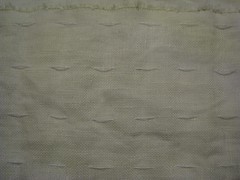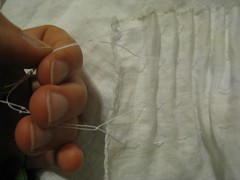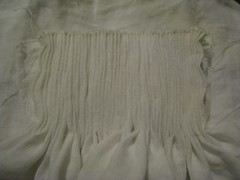An apron is one of those accessories that can really make the look of an outfit, particularly when dressing in the style of a working woman. (They don't disappear from the clothes of richer women, until you get to very formal court attire, they just get fancier and more decorative.) Aprons aren't just for women, either, some men wore them too (cooks, feast servers, butchers, etc., as well as specialized aprons for field workers and blacksmiths). Karen Larsdatter has an good collection of images of aprons.
The particular apron I am making here is a relatively fancy smocked apron, worn by women in the late 15th and early 16th centuries. I have tried to provide enough detailed photographs of the process that it could be used as a tutorial on making a similar apron, or and introduction to smocking in general. For more detailed reference, I suggest The Art of Manipulating Fabric, which has detailed instructions on several smocking techniques.
Materials: a large square of lightweight white linen, approximately 30 inches per side. It is helpful, but not necessary, to have the top edge be a selvedge. Light and medium weights of white thread.
Step 1: The first step is to run gathering threads. They will be used to pull the fabric into straight, even pleats, and it's important to spend the extra time to get them right. These threads will be removed from the final project, and it is important that they be both strong and very smooth. Because of that, I've used a smooth-finish cotton thread, even though I'm using linen thread everywhere else in the project. Polyester is fine too; just avoid colors that might bleed.
The gathering threads are stitched in a grid pattern of running stitch. The length of the stitches determines the depth of the pleats. What most important is that the threads are in straight, parallel rows, and that the stitches line up in vertical columns, going in and out in the same place. With practice and patience, this can be done by eye, matching the weave of the fabric to keep lines straight, but it's generally easier to mark out a grid with fabric chalk ahead of time. Knot the threads so they don't pull through, but don't secure them to the fabric
Step 2:As you go, you'll want to loosely gather up the fabric onto the threads, to make sure the pleats will fold up evenly.
Step 3:You want to have enough gathering threads that the pleats are secured for the entire area you plan to do smocking over. I recommend adding at least one more than you think you're going to need (you'll see why in part two). Once all the threads are in, tie them together in pairs on one side, and then you can start gathering the fabric into tight pleats.
Step 4:As you tight the pleats down onto the gathering threads, you may need to manually adjust some of the folds to lie flat, especially down at the last row of gathering. Fingerpress the correct crease into anything that's not behaving. Once the pleats are tight enough, tie off the threads at the other side. You do really want to make it as tight as you can - you don't want the pleats to be able to slide around on the foundation threads.
Subscribe to:
Post Comments (Atom)




2 comments:
hi there
I am desperate to fins research on smocked aprons being worn in the mid to late 15th Century. I have recently made one after looking at your blog and several others but I am being questioned in my society about the correctness of such an item.
I can only find lutteral psalter pictures but they are too early.
Any help that can give providence for the smocked apron would be very gratefully received ! Thanks!
Andrea
Examples that clearly show smocking tend to be early 16th century. The Karen Larsdatter's apron images (also linked above) show many plain and pleated aprons in the late 15th century, and the earliest smocked one I can find at the moment - Melencolia by Durer, 1514. There are also slightly later examples in images of landsknecht camp followers - see the seamstress c. 1535 near the bottom of this page.
Post a Comment